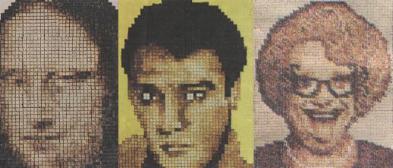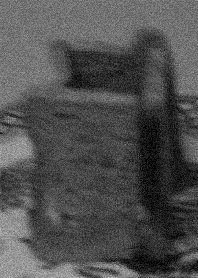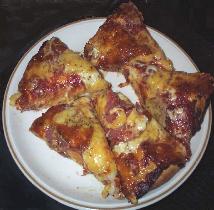|
The Baragamery (Penguin Cafe, Aberystwyth) where baragami was practised until September 2002. |
Baragamist Alison, with her trusty toaster. Alison made most of the toast arrangements shown on this website. |
BARAGAMI REVIEWS AND COMMENTS
The most frequently asked question was a request for photos of the baragamist who produced most of the designs illustrating this website. The second most frequent question was "Where can I see real live baragami?". Alison, baragamist extraordinaire at the Penguin Cafe in Aberystwyth has now left the Penguin Cafe and works with non-bread media, but we are hopeful that she has passed on her skills and knowledge to other baragamists.
|
The Baragamery (Penguin Cafe, Aberystwyth) where baragami was practised until September 2002. |
Baragamist Alison, with her trusty toaster. Alison made most of the toast arrangements shown on this website. |
Rhys Jones, April 1st, 2005
As a Welsh ex-pat, I have tried to keep alive the art of baragami among a small Welsh enclave in Adelaide. In my childhood, during Harvest Festival we built elaborate crosses from carefully shaped pieces of Bara Brith (not toast, which was considered unholy). Unlike baragami, the Bara Brith sculpture was held together with hatpins. These baragami-like crosses were the centrepieces on the Harvest Festival table at the front of the church in the Set Fawr (being one of the few occasions when Deacons had to sit with the common folk). The table was laden with produce from the four corners of the Earth and with a piece of coal to remind us of the beneficence of the Marquess of Bute. Sadly some preachers considered these bread sculptures to be "idolatry worthy of those who worshipped at the other chapel" and went so far as to smash the sculpture with Y Bibl. Although baragami is tolerated, probably due to its rarity, the baragami design known as "The Chapel I Don't Go To" commemorates their act of destruction.Nick Robinson, August 18, 2003
Sorry to be a real pedant, but "gami" means paper - it's the "ori" bit that referes to the folding, so I propose that the entire world or baragami is consigned to the dustbin and replaced with "oribara" - a much nicer and more accurate word all round. Should you not accept this proposal, I shall be obliged to form an oribara society and oppose your every move.In case you think I'm not being serious, have a look at www.poppadom.org.uk - I'm very serious about folding. POPPADOM stands for People Out Practising Paperfolding And Dining On Masala (curigami). See also www.britishorigami.org.uk - a site I maintain. You'll be delighted to know I shall be reviewing your activities in our magazine, which I edit....
Thank you for the crash course in Japanese, Richard. However, our resident (and non-Japanese speaking) baragamists feel that "Oribara" doesn't quite trip off the tongue like "baragami". Baragami - Fanatical about Folding
Di, New Zealand, January 13, 2003
I know you don't like toast sculpture, but what about toast mosaic art? It's a form of toast arranging native to New Zealand. 45 year old artist and supermarket owner Maurice Bennett of Wellington, New Zealand makes huge toast mosaics of faces. He's done the Mona Lisa, Elvis Presley, Jonah Lomu (rugby player), Dame Edna Everage. His 62 square foot portrait of Elvis Presley took over 4000 small slices of white toast and took 2 months to make. Dame Edna measures 7.35 metres by 5.85 metres and took 2989 slices - 187 loaves - and over a month to make. He also makes abstract designs and pop-art and is featured at art festivals.

He uses a 90-slice capacity commercial toaster at different settings for different shades of brown and a blowtorch for coal black. The mosaics are composed of six shades ranging from white (raw) through various golden browns to black (burnt). Weatherproofed toast mosaics have been displayed on buildings here. I think he's inspired by art's Old Toasters such as Remburnt, Buttercelli, Jam Gogh, Burner, Sconestable and Michelangeloaf.
Thank you for the pics Di. It may not be baragami, but it certainly is a form of toast arranging.
Llewellyn, Ceredigion, Cymru, January 9, 2003.
Dear Sir,
Thank you for showcasing our traditional toast-art. "Baragami" is a relatively recent name for what is an ancient art form. The original Welsh name has been lost. Always an art form passed on by oral tradition, baragami was undocumented and for a long while it was actively suppressed. I'm glad it has been preserved, or rediscovered, by a dedicated few. As part of our culture, it is deserving of a long overdue revival.
I remember well my childhood in an isolated Welsh valley which frequently got cut off by bad weather. There was nothing my family enjoyed more than making our own entertainment with toast. It was such a popular pastime in those days that many children carried round a box of stale toast and held baragami competitions in streets and school playgrounds.
If we were lucky, our parents took us to the toasteddfod (annual baragami gathering, like an eisteddfod but with bread instead of verse) to see master baragamists at work. How I envied their deft fingers. One year I was lucky enough to see Dai "The Crust" Evans himself! I haven't heard of a toasteddfod being held for many years now.

Mining was the bread and butter of our community I grew up in. My father and grandfather were miners. In those days, each mining community had its own Welsh Male Toast Ensemble. I loved watching our Male Toast Ensemble scrape toast in multi-part harmony, followed by a rousing mass toast-buttering with the actual baragami as their finale. Admittedly, one of the thrills for us children was when the toast was distributed after the performance. I always wanted to be a butterer in that Male Toast Ensemble, but it was one of many which were disbanded during pit closures. Mam said it was a pity as I had a real knife for buttery.
Later, when I was in my teens, I realised that baragami was also used as a political statement. Many an English family found a baragami design on the doorstep of their Welsh holiday home. If they failed to heed the warning, we set light to their holiday cottage and toasted bread on the flames.
During local and general elections, my wife and I placed plates of arranged toast in the window to indicate our political allegiance to warn off would-be canvassers. Guests were warned to avoid political discussion when we served them a plate of toast; arranging it into the design representing a political allegiance. Although we are generally hospitable to house-guests, some designs indicated that a guest had outstayed his welcome - many a guest departs swiftly after receiving such a design. It was a code that was understood throughout Wales.
Some scholars say that the political language of baragami dates back to when Wales was a kingdom under threat from the English. During meetings, secret messages were conveyed in baragami - a language the English could not understand. On defeating the Welsh, the English banned the serving of toast except in toast racks. The practising of baragami was suppressed, sometimes brutally, though many defied the ban at their own peril. The English enforced the use of toast racks in order to curb this expression of Welshness. Toast arranging most likely dates back even further, with threats being sent between individual Welsh kingdoms in the form of platters of arranged toast.
During the Second World War, many things in Britain were rationed. A standard loaf was introduced, providing a uniform baragami medium. This was a mixed blessing for baragami. Some baragamists said it made baragami easier and more accessible to the masses, but others argued that uniform slices destroyed some of the charm and much of the challenge, especially in three dimensional designs. Later on, of course, mass-produced "square slice" loaves such as Mother's Pride and Kingsmill continue to provide uniformity. My feelings on this are mixed. Dai The Crust would never have approved.
These days, baragami has largely lost its political associations and exists purely as a decorative art. My visiting grandchildren prefer to play computer games than join me for an evening of friendly baragami competition. At tea-time they laugh at my careful arrangements and joke "Look ma, grand-da's playing with his food again!" Thanks to your site I can demonstrate that baragami is an art form. My fondest hope is for a revival of the Welsh toasteddfods.
Paul Johnson, UK, January 2 2003
Despite receiving a new camera for xmas I still thought it would be a bit too weird to be taking pictures of my toast. Maybe I am missing the point here though.
Paul Johnson, UK, December 24, 2002
All very interesting designs on the website, but was nonetheless disappointed not to see the traditional "post drinking minge toast mountain" design featured - this is because it is the only one I can do with any sort of skill.
John, Truro, England, Jan 2003
Here is a photo of my arrangement "Roadkill" which also uses tomato sauce and cheese and peperoni.

Thanks John, but if unless I'm much mistaken it's actually a pizza.
Andy, Evesham, UK, December 12th, 2002
My wife works in a restaurant kitchen practising the traditional Evesham art of "asparagami" or "Asparagus Arranging". The most common arrangement is "The Bundle" in which the stalks are aligned like a bundle of sticks. However, asparagamists are now branching out into designs such as "Wigwam", "Witch's Broom" and "Jack Straws" [Pick-Up sticks].
No thanks Andy, I'll stick to toast-arranging if you cdon't mind. Asparagami - whatever will people think of next?
Legacy Online (Legacy Art & Book Works Inc), Volume 4, issue 46, December 3, 2002
Our website of the week falls under the heading of "You never know what the Welsh will come up with next..."
Larine Okolo (student), December 4, 2002
Just a tip - if you "butter" your toast before arranging it, wait till the toast cools down otherwise it becomes too soggy to stand up. Use real butter or good quality margarine. Low fat spread makes the toast go soggy.
Doris Toastenstein, November 18, 2002
I am extremely disappointed at the blatant discrimination against Toast Sculptors. Toast Sculpture is a well-developed art form here in East Anglia [Norfolk, Suffolk, North Essex, Britain]. An East Anglian woman set the gold standard for this intricate art with her sculpture of the Tower of London, complete with flags and pennants made from pieces of Kerrygold and Lurpak [brands of butter] wrappers. She followed this with her scale model masterpiece of the Cutty Sark with butter-wrapper sails. Unfortunately it sank when the toast went soggy. Baragami is crude and primitive compared to the complexity, detail and accuracy involved in toast sculpture.
I'm sorry you feel that way, Doris, but you're missing the point. In baragami, the designs are stripped down to a minimum so that the "essence" is conveyed with no need to over-burden the design with fussy details which force an observer into interpreting the design in a fixed way. Toast sculpture is static, while baragami can conveyconcepts, emotions and even an impressions of motion.
Walter, California, November 4, 2002
Is it permissible to paint the sides of 3D arrangements, for example The Chapel I Don't Go To, with peanut butter or yeast spread to give a sense of texture and colour?
No-one's going to stop you, Walter, but it won't be traditional baragami. Toasting white or granary bread for different time periods gives you a wide range of colours from off-white, through a whole spectrum of browns to almost black. If it's texture rather than authenticity you're after, try pumpernickel or one of those fancy loaves with bits of olive or sundried tomato in it. Of course, you could always claim that the toast arrived on your plate pre-spread, giving you no choice.
Darrin, Aberystwyth, Wales, October 21, 2002
It's not really baragami, but my mother told me a charming myth about how the Welsh discovered toast. A man fetching home bread from a nearby village and ran into a dragon on his way home. The dragon breathed fire at him and the man held the loaf of bread up to shield himself from the flames. The dragon's breath scorched the loaf, making the very first toast.
That's really neat Darrin, when was this?
1976. His local Spar store had run out of Mother's Pride [a brand of mass-produced white bread].
Bob Smith, London, England, October 19, 2002
Is it okay to use beef dripping instead of butter?
Of course it is, Bob. Bread and dripping is a traditional dish with roots as ancient and honourable as baragami itself. Baragamists have no problems regarding dripping, instead viewing it as a fusion of traditions. They do, however, draw the line at jam, marmalade and peanut butter.
Lorraine Evans, Ipswich, UK, July 9th, 2002
Baragami seems like a waste of toast. Hot buttered toast is toastally delicious. But the toast is no longer warm by the time you've finished folding and arranging it.
Eugene Griessel, South Africa, June 11, 2002
I decided to give the ancient Welsh art of Baragami a whirl. Grubbing around in my ancient freezer I found a suitably ancient loaf of square white bread. Toasting it in my ancient toaster, and sticking meticulously to the ancient rules about cutting, I laboriously constructed a Concorde in collision with a Tiger Moth over the pyramids. It was magnificent. And I would post a picture of it but while I was fetching a camera my ancient Welsh Corgi scoffed the lot.
Baragami Main PageReturn to Dragonqueen's Humor & Story Site
|
Affiliated to the Toast Leaners' Club |